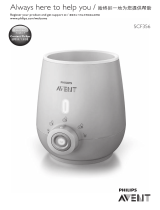
8
- Do not preheat the appliance.
- Always place a fully assembled bottle with cap in the
bottle warmer before you add water.
- Make sure you add water before you switch on the bottle
warmer.
- Hot water can cause serious burns. Be careful when the
bottle warmer contains hot water.
- Extreme caution must be used when moving an appliance
containing hot oil or other hot liquids.
- Do not touch hot surfaces. Use handles or knobs. The
accessible surfaces may become hot during use.
- Do not move the appliance when it contains hot water.
- When the food or milk has reached the required
temperature, remove the bottle or container from the
bottle warmer. If you leave food or milk in the bottle
warmer, the temperature of the food or milk increases.
- Before serving be sure the food is at safe temperature.
- Before serving, unplug the cord from the wall outlet and
dish. Do not leave the cord within child’s reach.
- Always turn the knob to “o” before you remove the plug
from the wall outlet.
Caution
- This appliance is intended to be used in household and
similar applications such as farm houses, bed and breakfast
type environments, sta kitchen areas in shops, oces
and other working environments, and by clients in hotels,
motels and other residential type environments.
- Unplug from outlet when not in use and before cleaning.
Allow to cool before putting on or taking o parts, and
before cleaning the appliance.
- The surface of the heating element is subject to residual
heat after use.
- Follow the descaling instructions to avoid irreparable damage.
- Do not try to open or repair the appliance yourself. You
can contact the Philips Consumer Care Centre in your
country (see www.philips.com/support).
- Do not use appliance for other than intended use.
ENGLISH

















